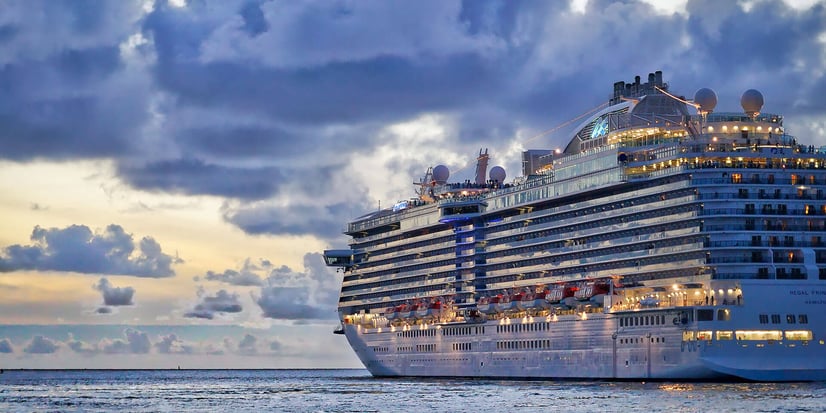Cruise liners – cities on the seas, the malls of the future

German Baltic Sea coast. A small harbor village with a beautiful old town within walking distance, 42,000 inhabitants. It is a fantastic June summer day. In the harbor, a fisherman lands his catch and a freighter unloads wood from Finland. A cruise liner also unloads her freight – cruise passengers. Six hundred tourists entering the town for a few hours. Good business for the local shop and restaurant owners, one might think; in fact, that’s just partially the case. A few souvenir stores are processing some sales, but most of the tourists are just window shopping. Same goes for the cafés and restaurants – no big business there, either.
Malls on the sea
Why are people passing by these charming local stores, and not stopping? It’s easily explained. Today’s cruise liners are very close to being actual cities on the seas. And just as cities, they have almost everything people might need. Restaurants, bars, shops, entertainment facilities, gyms and beauty salons – even amusement parks! – can be found on the vessels. The stopovers that the ship makes during the cruises are often just for sightseeing; all shopping necessities are taken care of on board.
An increasingly popular holiday choice
Today, going on a cruise has become almost as common as going for a beach vacation. As by a report of the Cruise Lines International Association (CLIA), in 2017 26.7 million passengers holidayed on the seas, across a fleet of 449 CLIA cruise liners. And that number is only going to increase. Following the growing demand, the number of vessels will increase by 21 in 2019. Ten of them will be so-called expedition ships, designed for adventure tours to the poles or into rivers. These will be equipped with the latest technologies, for example hybrid and LNG engines. Aboard the vessels, in the many shops, restaurants, bars and cinemas, guests will also be able to find the newest trends in customer experience and connectivity. Today, larger vessels can accommodate up to 6,500 passengers. The first of a new, world-class type of cruise liners is currently under construction. It will accommodate up to 9,500 passengers, and will be designed for family vacations. These huge vessels, true floating cities, might not even stop over at multiple harbors anymore. And why should they, when everything passengers need – from shopping, to entertainment, to delicious food – is already conveniently available on board? These ships might, instead, just hit the high seas for a week or two, and then head back.
Technology that can keep a floating city going
As cruising becomes more and more popular, and cruise liners get larger and more equipped, it’s worth taking a moment to reflect on the increasingly complex technological requirements that this evolution calls for. Everyone who works in retail and hospitality knows how fast-paced the business is, and how quickly consumer expectations change. Now put all of this on a ship – and keep in mind that your customers are stuck on it, perhaps for a couple of weeks. On top of that, once they leave the ship to head back home, you want them to go straight to your website, and book another trip. For that to happen, you need to make sure that the passengers are always entertained and satisfied with their options during their stay. This means that you need to give them exciting experiences, a great selection of products in your stores, excellent service, and a smooth, relaxed customer experience throughout. After all, these people are on holiday! They want things to be easy, fun, and exciting. No stress, no queuing, no errors. To match your guests’ expectations, you need technology that:- is modern and efficient, to avoid snags and delays, and deliver top-class experiences
- gives you clear insights into your guests’ tastes and preferences, so you can personalize the interactions
- provides you with real-time visibility into sales, available stock, and performance
- helps you deliver a consistent customer experience across the spectrum.
This can be hard to offer when you have to juggle multiple systems for retail, hospitality, ticketing, bookings, events – perhaps even rentals. Not to mention all these systems would be used on top of all the other requirements a cruise liner has! The best, simplest solution is to choose a unified management system for travel retail that includes specialized tools for retail, hospitality, bookings and events. This enables you to handle all your services (retail stores, restaurants, bars, entertainment areas) in an effortless, uniform way. When you are using just one system to manage your whole offering, it’s easy keep track of what’s going on in the different parts of the business. This visibility also enables you to fix situations (for example out of stocks of popular items, or wrongly priced products) in a timely way. Your customers will also get the benefits, as you can use the system’s insights to offer a product selection that matches their interests, personalized offers, smoother service and a better experience throughout. Interested in knowing more about the LS Retail solutions for travel retail? Drop us a line, we’ll be happy to help you find the software solution that matches your needs.

